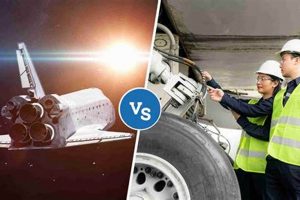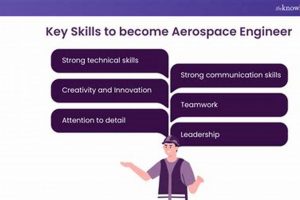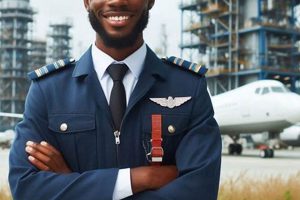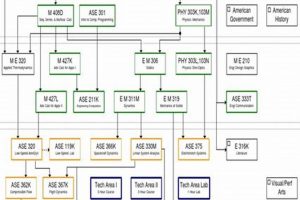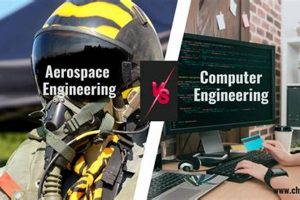Participation in activities outside the standard curriculum provides opportunities for students pursuing careers related to flight vehicle design, construction, and analysis to deepen their knowledge and skills. These pursuits can include joining rocketry clubs, participating in design competitions focused on aircraft or spacecraft, engaging in research projects with faculty, or securing internships at aerospace companies or government agencies. Such engagement expands understanding beyond theoretical concepts.
The value of these endeavors lies in their capacity to foster practical application of academic principles, cultivate teamwork and leadership abilities, and enhance professional networking opportunities. Historically, involvement in such initiatives has been a significant factor in securing employment and advancing careers within the aerospace sector. It demonstrates a commitment to the field beyond academic performance.
The following sections will elaborate on specific categories and examples of these engagement opportunities, detailing the skills developed and the potential career impact that can result from active participation. This exploration aims to provide a comprehensive overview of the benefits and avenues available for students seeking to augment their educational experience and prepare for successful careers in aerospace-related fields.
Guidance on Enhancing Aerospace Engineering Education
The following recommendations are designed to assist students in maximizing the value of their academic experience within the field. Strategic engagement in activities beyond the core curriculum is crucial for developing a well-rounded skillset and enhancing career prospects.
Tip 1: Prioritize Hands-On Projects: Seek opportunities to participate in projects involving the design, construction, and testing of aerospace systems. Examples include building and launching rockets, designing unmanned aerial vehicles (UAVs), or contributing to CubeSat projects. Practical experience complements theoretical knowledge.
Tip 2: Engage in Design Competitions: Participate in nationally recognized design competitions such as those hosted by the American Institute of Aeronautics and Astronautics (AIAA). These competitions provide a platform to apply engineering principles to solve real-world problems and showcase technical skills.
Tip 3: Pursue Research Opportunities: Collaborate with faculty on research projects related to areas such as aerodynamics, propulsion, materials science, or space systems. Research experience develops critical thinking, problem-solving abilities, and technical writing skills.
Tip 4: Secure Relevant Internships: Seek internships at aerospace companies, government agencies (e.g., NASA, Department of Defense), or research laboratories. Internships provide invaluable industry exposure, networking opportunities, and practical experience that enhances employability.
Tip 5: Join Professional Organizations: Become a student member of professional organizations such as AIAA or the Society of Women Engineers (SWE). These organizations offer access to conferences, workshops, and networking events that facilitate professional development.
Tip 6: Develop Technical Communication Skills: Hone the ability to effectively communicate technical information through written reports, presentations, and technical drawings. Strong communication skills are essential for collaborating with colleagues and conveying technical concepts to non-technical audiences.
Tip 7: Cultivate Teamwork and Leadership Skills: Actively participate in team-based projects and seek leadership roles within student organizations. The ability to work effectively in teams and lead diverse groups is highly valued in the aerospace industry.
By strategically engaging in these activities, students can significantly enhance their technical skills, expand their professional network, and increase their competitiveness in the job market. Active participation demonstrates a commitment to the field and a proactive approach to career development.
The subsequent sections will delve deeper into specific areas of aerospace engineering, providing insights into current trends, emerging technologies, and potential career paths.
1. Project-Based Learning
Project-Based Learning (PBL) serves as a cornerstone of effective learning within aerospace engineering, particularly when integrated into activities outside the traditional curriculum. It fosters a deeper understanding of theoretical concepts through practical application and hands-on experience. The following facets highlight the significant role of PBL in augmenting aerospace engineering education.
- Application of Theoretical Knowledge
PBL facilitates the practical application of theoretical knowledge acquired in the classroom. Students engaged in projects such as designing and building rockets or unmanned aerial vehicles (UAVs) directly apply principles of aerodynamics, propulsion, and structural mechanics. This reinforces understanding and demonstrates the real-world relevance of academic concepts.
- Development of Engineering Skills
PBL cultivates essential engineering skills, including problem-solving, critical thinking, and design optimization. Projects often require students to identify challenges, propose solutions, conduct experiments, and analyze data. This iterative process mirrors the engineering design cycle and prepares students for the demands of professional practice.
- Teamwork and Collaboration
Many aerospace engineering projects are collaborative endeavors, requiring students to work effectively in teams. PBL promotes teamwork, communication, and leadership skills. Students learn to delegate tasks, manage resources, and resolve conflicts, simulating the collaborative environment of the aerospace industry.
- Real-World Problem Solving
PBL often involves addressing real-world problems or challenges faced by the aerospace industry. For example, students may be tasked with designing a more efficient aircraft wing, developing a sustainable propulsion system, or optimizing satellite orbits. This exposure to real-world problems enhances their ability to innovate and contribute to the advancement of aerospace technology.
In conclusion, Project-Based Learning significantly enhances the educational experience within aerospace engineering by providing opportunities to apply theoretical knowledge, develop essential engineering skills, foster teamwork, and address real-world problems. Integration of PBL within activities such as rocketry clubs, design competitions, and undergraduate research projects prepares students for successful careers in the aerospace sector.
2. Design Competitions
Design competitions form a critical component of aerospace engineering extracurricular activities, providing students with tangible opportunities to apply theoretical knowledge acquired in the classroom. The competitive environment fosters innovation, problem-solving, and teamwork skills essential for success in the aerospace industry. These events serve as a proving ground where concepts are tested and refined under realistic constraints, often mirroring the challenges encountered in actual engineering projects. For instance, the AIAA Design/Build/Fly competition tasks teams with designing, building, and flying a radio-controlled aircraft to meet specific mission requirements. The competition promotes the practical integration of aerodynamics, propulsion, and structural analysis principles.
Participating in design competitions not only enhances technical expertise but also cultivates vital soft skills. Teams must effectively manage resources, adhere to strict deadlines, and communicate technical information clearly and concisely. The collaborative nature of these events necessitates efficient teamwork and leadership. Furthermore, exposure to industry professionals who serve as judges or mentors provides invaluable networking opportunities and insights into current aerospace practices. Examples include the SAE Aero Design competition and the NASA University Student Launch Initiative, each focusing on different aspects of aerospace engineering and offering unique learning experiences. Such participation directly contributes to a student’s resume, signaling a proactive approach to learning and a commitment to the field beyond academic requirements.
In summation, design competitions are instrumental in bridging the gap between theoretical knowledge and practical application within aerospace engineering education. Their inclusion within extracurricular activities offers multifaceted benefits, ranging from enhanced technical skills to the development of teamwork and communication abilities. Successful participation demonstrates a student’s capability to handle complex engineering challenges and contribute effectively to a team, enhancing their employability and setting the stage for a successful career within the aerospace sector.
3. Research Participation
Integration into research endeavors represents a critical avenue for aerospace engineering students to supplement their formal education. Active involvement in research projects provides opportunities to apply theoretical knowledge, develop analytical skills, and contribute to advancements within the field. These research experiences, typically conducted outside of required coursework, constitute a significant component of well-rounded preparation for a career in aerospace engineering.
- Development of Advanced Analytical Skills
Participation in research necessitates the utilization of advanced analytical techniques to interpret data, model complex systems, and draw meaningful conclusions. Students engaged in research projects related to aerodynamics, propulsion, or materials science learn to employ computational tools and experimental methodologies to investigate intricate engineering problems. This exposure equips them with skills that are highly valued in both academic and industrial settings.
- Contribution to Technological Advancement
Undergraduate research experiences can contribute to the advancement of aerospace technology. Students may work alongside faculty and graduate students to develop innovative designs, test new materials, or improve existing systems. These contributions, even if incremental, expose students to the process of scientific discovery and provide them with a sense of ownership and accomplishment.
- Enhanced Understanding of Engineering Principles
Engagement in research reinforces understanding of fundamental engineering principles by requiring students to apply theoretical concepts to practical problems. Unlike textbook exercises, research projects often involve unforeseen challenges and require creative problem-solving. The process of troubleshooting experimental setups, interpreting unexpected results, and refining models deepens comprehension and fosters a more intuitive grasp of engineering concepts.
- Preparation for Graduate Studies and Research Careers
Undergraduate research participation serves as valuable preparation for graduate studies and careers in research. Students who have engaged in research projects are better equipped to handle the demands of graduate-level coursework and independent research. Furthermore, research experience strengthens applications for graduate programs and provides a competitive edge in the job market for research-oriented positions.
The facets outlined above underscore the pivotal role of research participation in shaping well-rounded aerospace engineers. By engaging in research projects, students acquire advanced analytical skills, contribute to technological advancement, deepen their understanding of engineering principles, and prepare for future academic and professional pursuits. These experiences, when integrated within the broader context of aerospace engineering extracurricular activities, serve as a catalyst for professional growth and innovation.
4. Industry Internships
Industry internships represent a critical component within the spectrum of aerospace engineering extracurricular activities. These structured work experiences provide practical application of theoretical knowledge and exposure to real-world engineering challenges, bridging the gap between academic studies and professional practice.
- Application of Theoretical Knowledge
Internships allow students to apply the principles learned in the classroom to actual engineering projects. For instance, an intern at Boeing might utilize finite element analysis software to analyze stress distribution in an aircraft wing, reinforcing their understanding of structural mechanics and material properties. This hands-on experience solidifies theoretical concepts and demonstrates their practical relevance within the aerospace industry.
- Development of Practical Skills
Internships facilitate the development of essential practical skills that are often not emphasized in academic settings. Students gain experience using industry-standard software, working with specialized equipment, and adhering to established engineering processes and protocols. An internship at NASA might involve designing and testing components for a satellite, requiring the intern to develop proficiency in CAD software, prototyping techniques, and data analysis methods. These skills enhance their employability and prepare them for the demands of professional practice.
- Professional Networking Opportunities
Internships provide valuable opportunities for networking with industry professionals. Students interact with engineers, managers, and other experts in their field, building relationships that can lead to future employment opportunities. Interns may attend industry events, participate in team meetings, and collaborate on projects, expanding their professional network and gaining insights into career paths within the aerospace industry.
- Career Exploration and Guidance
Internships allow students to explore different areas within aerospace engineering and gain clarity on their career interests. An intern at SpaceX might work on various projects related to rocket propulsion, spacecraft design, or mission planning, providing them with a comprehensive understanding of the diverse opportunities within the company. This experience can help students refine their career goals and make informed decisions about their future academic and professional pursuits.
In summary, industry internships are an integral aspect of aerospace engineering extracurricular activities, offering practical application, skill development, networking opportunities, and career guidance. By actively seeking and participating in internships, students enhance their academic experience, increase their employability, and prepare for a successful career within the aerospace sector. These experiences demonstrate a commitment to the field beyond academic performance, making students more competitive in the job market.
5. Networking Opportunities
Networking opportunities constitute a vital, often understated, component of aerospace engineering extracurricular activities. The relationships cultivated through participation in clubs, competitions, research projects, and internships extend beyond the immediate project and create a professional support system that can influence career trajectories. Involvement in AIAA student chapters, for example, provides exposure to industry professionals through conferences and workshops. This interaction allows students to learn about current industry trends, potential career paths, and gain valuable advice from experienced engineers. This active engagement facilitates the transition from academic studies to professional practice.
The benefits of these networking opportunities extend beyond initial job placement. Contacts made during extracurricular activities can serve as mentors, collaborators, and references throughout an aerospace engineer’s career. For instance, a student who participates in the NASA University Student Launch Initiative may connect with engineers who later provide guidance on graduate school applications or offer insights into specific research areas. Furthermore, alumni networks associated with university aerospace programs often actively support current students by providing internship opportunities and career advice, demonstrating the long-term impact of these early connections. These connections can be useful when considering promotions or career changes later in life.
In summary, networking opportunities derived from active participation in aerospace engineering extracurricular activities represent a critical investment in future career success. The relationships formed during these experiences provide access to valuable mentorship, industry insights, and potential job opportunities. While technical skills are undoubtedly essential, the ability to build and maintain a strong professional network significantly enhances an aerospace engineer’s career prospects and contributes to their long-term success within the industry.
6. Skill Development
The cultivation of critical skills is a central objective of participation in aerospace engineering extracurricular activities. These activities offer a platform for students to develop competencies that extend beyond the theoretical knowledge acquired in the classroom, enhancing their preparedness for the demands of professional practice.
- Technical Proficiency
Aerospace-related projects and competitions, such as designing and building rockets or UAVs, provide hands-on experience that cultivates technical proficiency. Students gain practical knowledge of aerodynamics, propulsion, structural mechanics, and control systems. For example, participation in a rocketry club allows students to apply physics principles to design stable and efficient rockets, developing their understanding of rocket propulsion and flight dynamics.
- Problem-Solving Abilities
Extracurricular activities often present complex engineering challenges that require students to develop effective problem-solving strategies. Design competitions, such as the AIAA Design/Build/Fly competition, require teams to optimize aircraft performance within specific constraints. This process involves identifying problems, generating potential solutions, conducting trade studies, and implementing the optimal design. These activities enhance analytical thinking and the ability to approach complex engineering problems systematically.
- Teamwork and Communication
Many aerospace engineering projects and competitions are collaborative endeavors that require effective teamwork and communication. Students learn to delegate tasks, manage resources, and resolve conflicts while working towards a common goal. Participating in a CubeSat project, for example, necessitates clear communication and coordination among team members with diverse technical expertise. These experiences cultivate interpersonal skills essential for success in collaborative work environments.
- Leadership and Project Management
Taking on leadership roles within extracurricular organizations or leading project teams provides opportunities to develop leadership and project management skills. Students learn to motivate and guide team members, manage project timelines, allocate resources effectively, and make strategic decisions. Organizing a regional aerospace engineering conference or leading a design team in a competition provides invaluable experience in planning, organizing, and executing complex projects, enhancing leadership abilities and project management expertise.
These facets of skill development highlight the significant benefits of participation in aerospace engineering extracurricular activities. The acquisition of technical proficiency, problem-solving abilities, teamwork and communication skills, and leadership and project management capabilities prepares students for the challenges and opportunities of a career in the aerospace industry, increasing their competitiveness in the job market and setting the stage for professional success.
7. Professional Growth
Participation in extracurricular activities related to aerospace engineering significantly contributes to professional growth by providing opportunities to develop skills, build networks, and gain experiences that enhance career prospects. The effect of such participation is a more well-rounded and competitive graduate. Specifically, engagement in design competitions, research projects, and internships allows students to apply theoretical knowledge in practical settings, fostering critical thinking, problem-solving, and teamwork abilities. These competencies are highly valued by employers in the aerospace industry. Further, involvement demonstrates a commitment to the field that extends beyond academic coursework.
The importance of professional growth as a component of extracurricular engagement is evident in the career trajectories of many successful aerospace engineers. For example, students who actively participate in rocketry clubs or UAV design teams often secure internships at leading aerospace companies or research institutions. These internships, in turn, provide invaluable experience and networking opportunities that can lead to full-time employment after graduation. Furthermore, participation in professional organizations, such as AIAA, offers access to mentorship programs, conferences, and workshops that facilitate professional development and career advancement. The culmination of these various experiences significantly accelerates professional development.
In summary, active participation in aerospace engineering extracurricular activities is a catalyst for professional growth. It provides a platform for skill development, networking, and practical experience, enhancing career prospects and contributing to long-term success in the field. While academic achievement is essential, extracurricular engagement distinguishes students by demonstrating initiative, commitment, and a passion for aerospace engineering that extends beyond the classroom. This translates into tangible advantages in securing employment and advancing within the aerospace industry, positioning them for continued professional development throughout their careers.
Frequently Asked Questions
The following addresses common inquiries regarding participation in activities outside the standard aerospace engineering curriculum. The purpose is to provide clarity on the benefits and requirements associated with such engagement.
Question 1: What constitutes “aerospace engineering extracurricular activities”?
The term encompasses a broad range of activities beyond required coursework, including participation in design competitions (e.g., AIAA Design/Build/Fly), research projects with faculty, industry internships, membership in professional organizations (e.g., AIAA, SWE), and involvement in student-led clubs focused on aerospace-related topics (e.g., rocketry, UAVs).
Question 2: Why is participation in these activities considered important?
Engagement enhances practical skills, facilitates the application of theoretical knowledge, cultivates teamwork and leadership abilities, and provides networking opportunities with industry professionals. These experiences enhance career readiness and improve employment prospects upon graduation.
Question 3: What are the typical time commitments associated with these activities?
Time commitments vary depending on the activity. Internships are typically full-time summer positions. Research projects may require several hours per week during the academic year. Design competitions often involve intensive periods of work leading up to competition events. Prospective participants should carefully consider the time commitment required before committing to an activity.
Question 4: How are these activities funded?
Funding sources vary. Some activities, such as research projects, may be funded through grants or university resources. Design competitions often require teams to seek sponsorship from industry partners or raise funds through university channels. Internships are typically paid positions. Membership fees for professional organizations are usually the responsibility of the student.
Question 5: What skills are typically gained from participating in these activities?
Skills gained include technical proficiency in areas such as aerodynamics, propulsion, and structural analysis; problem-solving abilities; teamwork and communication skills; project management capabilities; and networking skills. These skills are highly valued by employers in the aerospace industry.
Question 6: How can a student identify and participate in these opportunities?
Students should consult with their academic advisors, review university websites and bulletin boards, attend departmental information sessions, and network with faculty and upper-class students to identify available opportunities. Active participation in professional organizations and attendance at industry events can also provide valuable leads.
In conclusion, strategic engagement in these activities augments academic learning, fosters professional development, and significantly enhances career readiness for aspiring aerospace engineers. Thoughtful planning and active participation are essential for maximizing the benefits derived from these experiences.
The subsequent sections will provide additional insights into navigating the career landscape within the aerospace industry.
Conclusion
This exploration has illuminated the critical role that aerospace engineering extracurricular activities play in supplementing formal education. These activities, ranging from design competitions and research projects to industry internships and professional organization involvement, provide students with opportunities to develop practical skills, expand their professional networks, and enhance their understanding of real-world engineering challenges. The benefits extend beyond the acquisition of technical expertise to encompass the cultivation of teamwork, communication, and leadership abilities.
The strategic engagement in these activities is not merely an optional enhancement but a fundamental component of preparing for a successful career in the competitive aerospace industry. Students are encouraged to actively seek out and participate in these experiences to maximize their potential and contribute to the advancement of aerospace technology. The future of aerospace engineering relies on the continuous development of skilled and well-rounded professionals, and extracurricular activities are an essential pathway to achieving this goal.


